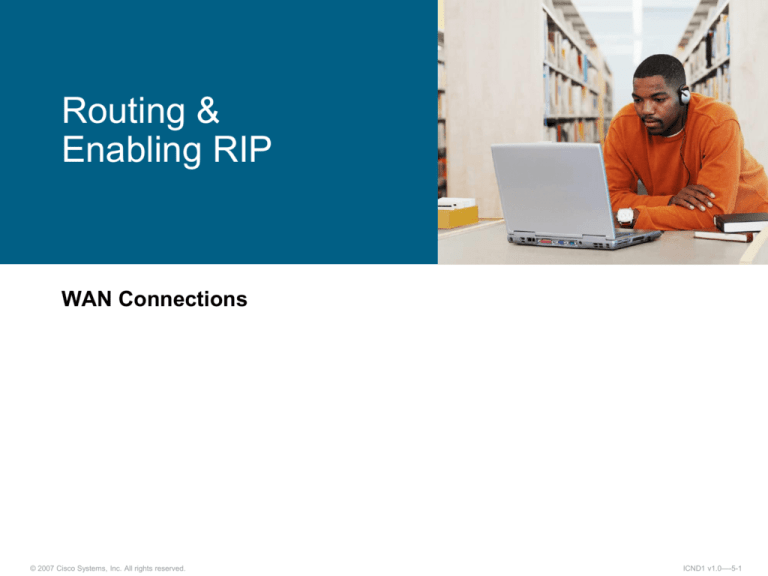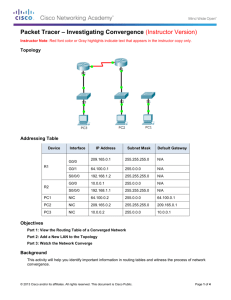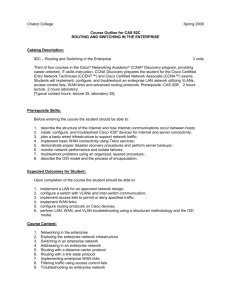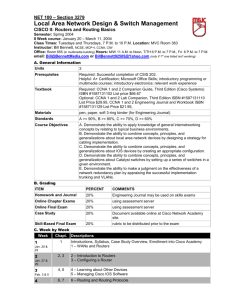
Routing &
Enabling RIP
WAN Connections
© 2007 Cisco Systems, Inc. All rights reserved.
ICND1 v1.0—-5-1
Module Overview
Overview routing.
What Is a Routing Protocol?
Concepts: AS, AD, Classful, Classless, Distance
Vector, Link State, Hybrid.
RIP Overview
IP Routing Configuration Tasks
RIP Configuration
© 2007 Cisco Systems, Inc. All rights reserved.
ICND1 v1.0—5-2
What Is a Routing Protocol?
Routing protocols
are used between
routers to determine
paths and maintain
routing tables.
After the path is
determined, a router
can route a routed
protocol.
© 2007 Cisco Systems, Inc. All rights reserved.
ICND1 v1.0—5-3
Overview routing
© 2007 Cisco Systems, Inc. All rights reserved.
ICND1 v1.0—5-4
Autonomous Systems: Interior or
Exterior Routing Protocols
An autonomous system is a collection of networks under a
common administrative domain.
IGPs operate within an autonomous system.
EGPs connect different autonomous systems.
© 2007 Cisco Systems, Inc. All rights reserved.
ICND1 v1.0—5-5
Administrative Distance:
Ranking Routes
Routers choose the routing source with the
best administrative distance:
RIP has an administrative distance of 120.
OSPF has an administrative distance of 110.
EIGRP has an administrative distance of 90.
© 2007 Cisco Systems, Inc. All rights reserved.
ICND1 v1.0—5-6
Classful Routing Protocol
Classful routing protocols do not include the subnet mask with the
route advertisement.
Within the same network, consistency of the subnet masks is
assumed.
Summary routes are exchanged between foreign networks.
These are examples of classful routing protocols:
– RIPv1
– IGRP (not now)
© 2007 Cisco Systems, Inc. All rights reserved.
ICND1 v1.0—5-7
Classless Routing Protocol
Classless routing protocols include the subnet mask with the
route advertisement.
Classless routing protocols support a variable-length subnet mask
(VLSM).
Summary routes can be manually controlled within the network.
These are examples of classless routing protocols:
– RIPv2
– EIGRP
– OSPF
– IS-IS
© 2007 Cisco Systems, Inc. All rights reserved.
ICND1 v1.0—5-8
Distance Vector Routing Protocols
Routers pass periodic copies of their routing table to neighboring
routers and accumulate distance vectors
© 2007 Cisco Systems, Inc. All rights reserved.
ICND1 v1.0—5-9
Sources of Information and Discovering
Routes
Routers discover the best path to destinations from each neighbor.
© 2007 Cisco Systems, Inc. All rights reserved.
ICND1 v1.0—5-10
Link-State Routing Protocols
After an initial flood of LSAs, link-state routers pass small,
event-triggered link-state updates to all other routers.
© 2007 Cisco Systems, Inc. All rights reserved.
ICND1 v1.0—5-11
Benefits and Drawbacks of Link-State Routing
Benefits of link-state routing:
– Fast convergence:
Changes are reported immediately by the affected source
– Robustness against routing loops:
Routers know the topology
Link-state packets are sequenced and acknowledged
– Hierarchical network design enables optimization of resources.
Drawbacks of link-state routing:
– Significant demands for resources:
Memory (three tables: adjacency, topology, forwarding)
CPU (Dijkstra’s algorithm can be intensive, especially when there are many
instabilities)
– Requires very strict network design
– Configuration can be complex when tuning various parameters and
when design is complex
© 2007 Cisco Systems, Inc. All rights reserved.
ICND1 v1.0—5-12
Hybrid
EIGRP
Advanced distance vector
Rapid convergence
100% loop-free classless routing
Easy configuration
Incremental updates
Load balancing across equaland unequal-cost pathways
© 2007 Cisco Systems, Inc. All rights reserved.
Flexible network design
Multicast and unicast instead of broadcast
address
Support for VLSM and discontiguous subnets
Manual summarization at any point in the
internetwork
Support for multiple network layer protocols
ICND1 v1.0—5-13
RIP Overview
Distance vector protocol.
Routers update every 30 seconds
Hop-count metric selects the path
Metric = hop count
(Maximum is 16 equal-cost paths (default = 4), if metric >=16 -> infinity.)
RIP used UDP – port 520.
AD (Administrative Distance) = 120.
RIP v1 and RIP v2.
© 2007 Cisco Systems, Inc. All rights reserved.
ICND1 v1.0—5-14
RIP OPERATION
© 2007 Cisco Systems, Inc. All rights reserved.
ICND1 v1.0—5-15
RIP OPERATION
Routing table send from R3 to R2
Routing table of R2
© 2007 Cisco Systems, Inc. All rights reserved.
ICND1 v1.0—5-16
RIP OPERATION
Routing table send from R2 to R1
Routing table of R2
© 2007 Cisco Systems, Inc. All rights reserved.
ICND1 v1.0—5-17
RIP OPERATION
© 2007 Cisco Systems, Inc. All rights reserved.
ICND1 v1.0—5-18
RIP OPERATION
© 2007 Cisco Systems, Inc. All rights reserved.
ICND1 v1.0—5-19
Routing Loops
Net 192.68.3.0/24 down
Cause network loops
© 2007 Cisco Systems, Inc. All rights reserved.
ICND1 v1.0—5-20
Solution to Routing Loops: Split Horizon
It is never useful to send information about a route back
in the direction from which the original information came.
© 2007 Cisco Systems, Inc. All rights reserved.
ICND1 v1.0—5-21
Solution to Routing Loops:
Route Poisoning
- Routers advertise the distance of routes that have gone down to
infinity.
- The release updates for subnet down is done immediately without
having to wait until the periodic (call this the triggered update).
© 2007 Cisco Systems, Inc. All rights reserved.
ICND1 v1.0—5-22
Solution to Routing Loops:
Route Poisoning and Poison Reverse
Poison reverse overrides split horizon.
© 2007 Cisco Systems, Inc. All rights reserved.
ICND1 v1.0—5-23
Solution to Routing Loops:
Hold-Down Timers
192.168.3.0 s2/1
Metric = 1
192.168.3.0 s2/1
Metric = 1
192.168.3.0 s2/1
Metric = 2
192.168.3.0 s2/1
Metric = 2
192.168.3.0 s2/1
Metric = 1
© 2007 Cisco Systems, Inc. All rights reserved.
192.168.3.0 s2/1
Metric = 1
192.168.3.0 s2/1
Metric = 0
192.168.3.0 s2/1
Metric = 0
ICND1 v1.0—5-24
Solution to Routing Loops:
Hold-Down Timers
192.168.3.0 s2/0
s2/1
Metric
Metric==16
2
192.168.3.0 s2/1
Metric = 1
192.168.3.0 s2/1
Metric
Metric ==16
3
Chưa đến được R2
© 2007 Cisco Systems, Inc. All rights reserved.
192.168.3.0 s2/1
Metric = 16
ICND1 v1.0—5-25
Solution to Routing Loops:
Hold-Down Timers
Holddown
timer(180s)
192.168.3.0 s2/1
Metric = 16
192.168.3.0 s2/1
Metric = 1
192.168.3.0 s2/1
Metric = 16
Chưa đến được R2
© 2007 Cisco Systems, Inc. All rights reserved.
192.168.3.0 s2/1
Metric = 16
ICND1 v1.0—5-26
Solution to Routing Loops:
Update Timers
192.168.3.0 s2/1
Metric = 16
Update
timer(30s)
192.168.3.0 s2/1
Metric = 16
© 2007 Cisco Systems, Inc. All rights reserved.
ICND1 v1.0—5-27
Solution to Routing Loops:
Update timer - Invalid timer – Flush timer
192.168.3.0 s2/1
Update
timer(30s)
Waiting…
(150s)
Invalid
timer(180s)
Waiting…
(60s)
Flush
timer(240s)
192.168.3.0 s2/1
Metric = 16
192.168.3.0 s2/1
Metric = 16
© 2007 Cisco Systems, Inc. All rights reserved.
ICND1 v1.0—5-28
© 2007 Cisco Systems, Inc. All rights reserved.
ICND1 v1.0—5-29
IP Routing Configuration Tasks
Router configuration
– Select routing protocols
– Specify networks or interfaces
© 2007 Cisco Systems, Inc. All rights reserved.
ICND1 v1.0—5-30
RIPv1 and RIPv2 Comparison
RIPv1
RIPv2
Classful
Classless
Supports variable-length subnet mask?
No
Yes
Sends the subnet mask along with the routing
update?
No
Yes
Broadcast
Multicast
255.255.255.255
224.0.0.9
RFC 1058
RFCs 1721,
1722, and 2453
Supports manual route summarization?
No
Yes
Authentication support?
No
Yes
Routing protocol
Addressing type (update route)
Defined in …
© 2007 Cisco Systems, Inc. All rights reserved.
ICND1 v1.0—5-31
RIP Configuration
RouterX(config)# router rip
Starts the RIP routing process
RouterX(config-router)# version 2
Enables RIP version 2
RouterX(config-router)# network network-number
Selects participating attached networks
Requires a major classful network number
© 2007 Cisco Systems, Inc. All rights reserved.
ICND1 v1.0—5-32
RIP Configuration Example
© 2007 Cisco Systems, Inc. All rights reserved.
ICND1 v1.0—5-33
Verifying the RIP Configuration
Routing Protocol is "rip"
Sending updates every 30 seconds, next due in 6 seconds
Invalid after 180 seconds, hold down 180, flushed after 240
Outgoing update filter list for all interfaces is not set
Incoming update filter list for all interfaces is not set
Redistributing: rip
Default version control: send version 2, receive version 2
Interface
Send Recv Triggered RIP Key-chain
FastEthernet0/0
2
2
Serial0/0/2
2
2
Automatic network summarization is in effect
Maximum path: 4
Routing for Networks:
10.0.0.0
172.16.0.0
Routing Information Sources:
Gateway
Distance
Last Update
10.1.1.2
120
00:00:25
Distance: (default is 120)
RouterA#
© 2007 Cisco Systems, Inc. All rights reserved.
ICND1 v1.0—5-34
Displaying the IP Routing Table
RouterA# show ip route
Codes: C - connected, S - static, I - IGRP, R - RIP, M - mobile, B - BGP
D - EIGRP, EX - EIGRP external, O - OSPF, IA - OSPF inter area
N1 - OSPF NSSA external type 1, N2 - OSPF NSSA external type 2
E1 - OSPF external type 1, E2 - OSPF external type 2, E - EGP
i - IS-IS, L1 - IS-IS level-1, L2 - IS-IS level-2, * - candidate default
U - per-user static route, o - ODR
T - traffic engineered route
Gateway of last resort is not set
C
R
C
R
172.16.0.0/24 is subnetted, 1 subnets
172.16.1.0 is directly connected, fastethernet0/0
10.0.0.0/24 is subnetted, 2 subnets
10.2.2.0 [120/1] via 10.1.1.2, 00:00:07, Serial0/0/2
10.1.1.0 is directly connected, Serial0/0/2
192.168.1.0/24 [120/2] via 10.1.1.2, 00:00:07, Serial0/0/2
© 2007 Cisco Systems, Inc. All rights reserved.
ICND1 v1.0—5-35
debug ip rip Command
RouterA# debug ip rip
RIP protocol debugging is on
RouterA#
00:06:24: RIP: received v1 update from 10.1.1.2 on Serial0/0/2
00:06:24:
10.2.2.0 in 1 hops
00:06:24:
192.168.1.0 in 2 hops
00:06:33: RIP: sending v1 update to 255.255.255.255 via FastEthernet0/0 (172.16.1.1)
00:06:34:
network 10.0.0.0, metric 1
00:06:34:
network 192.168.1.0, metric 3
00:06:34: RIP: sending v1 update to 255.255.255.255 via Serial0/0/2 (10.1.1.1)
00:06:34:
network 172.16.0.0, metric 1
© 2007 Cisco Systems, Inc. All rights reserved.
ICND1 v1.0—5-36
Summary
Routing is the process by which items get from one location to
another.
Dynamic routing protocols determine how updates are conveyed,
what knowledge is conveyed, when to convey knowledge, and
how to locate recipients of the updates.
A routing protocol that has a lower administrative value is more
trustworthy than a protocol that has a higher administrative value.
There are three classes of routing protocols: distance vector, linkstate, and balanced hybrid.
The ip classless command can be used to prevent a router from
dropping a packet that is destined for an unknown subnetwork of
a directly attached network if a default route is configured.
© 2007 Cisco Systems, Inc. All rights reserved.
ICND1 v1.0—5-37
Summary (Cont.)
RIP is a distance vector routing protocol that uses hop count as
the matrix for route selection and broadcasts updates every 30
seconds.
RIPv1 uses classful routing protocol; RIPv2 uses classless routing
protocol. RIPv2 supports VLSM, manual route summarization,
and authentication; RIPv1 does not support these activities.
To enable a dynamic routing protocol, first a routing protocol is
selected, then IP network numbers are assigned without values
being specified (except OSPF).
The router command starts the routing process. The network
command allows the routing process to determine which
interfaces will participate in sending and receiving the routing
updates.
© 2007 Cisco Systems, Inc. All rights reserved.
ICND1 v1.0—5-38
Summary (Cont.)
The router RIP command selects RIP as the routing protocol. The
network command identifies a participating attached network.
The show ip command displays information about routing
protocols and the routing table.
The debug ip rip command displays information on RIP routing
transactions.
© 2007 Cisco Systems, Inc. All rights reserved.
ICND1 v1.0—5-39
© 2007 Cisco Systems, Inc. All rights reserved.
ICND1 v1.0—5-40









